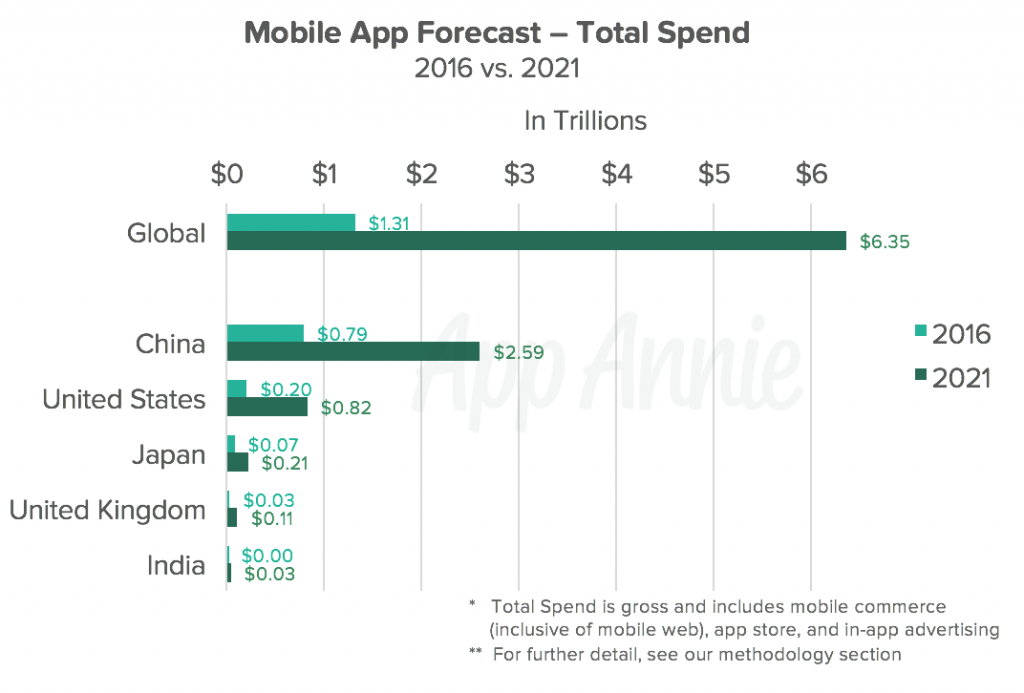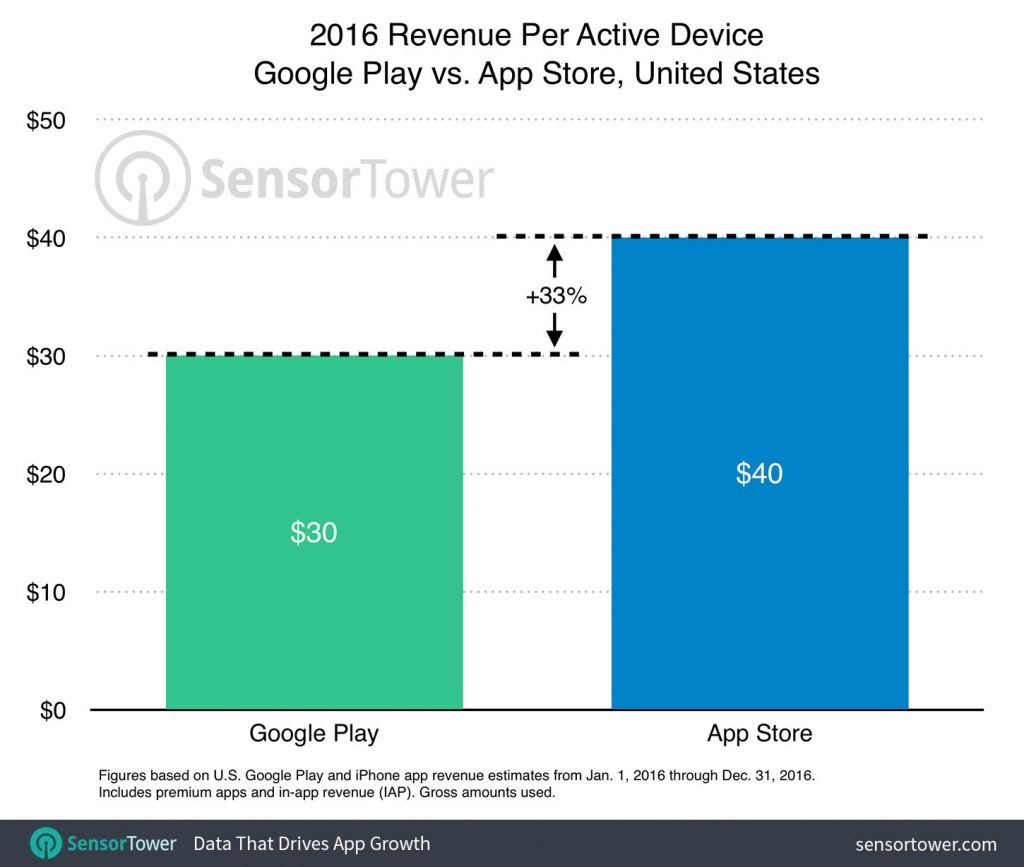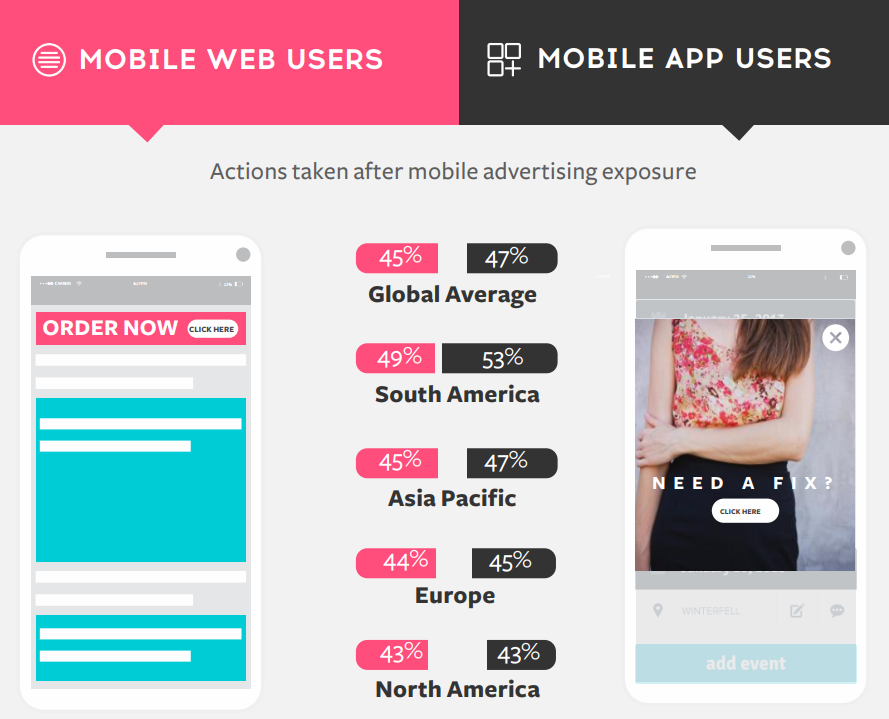The “failing” New York Times reported, on America’s birthday no less, that despite the economic optimism US businesses shared following President Trump’s election, the actual numbers show that the economy is stagnant. That’s a bummer, to be sure, but there is good news! At least, there is if you’re in the mobile industry because mobile spending is up! Let’s first look at the big revenue picture, then get into some specifics.
The mobile app economy is a ripening peach.
According to the latest report by App Annie, the global app economy will be worth over $6 trillion by 2021.

Even though by now everyone is aware that mobile is big business, the estimated growth in just the next four years is almost unbelievable. As more and more of the world is set to increase the use of mobile devices, mobile payments, and mobile shopping; this economy is set to make smart businesses very rich.
So how can you get in on this? We’ve written about this before, such as why going “mobile-first” is so important to capitalizing on this global growth and how to make your business’ app better for your users (so they shop more). But let’s examine the three areas that App Annie points out that will be responsible for the $6 trillion: the app store, in-app advertising, and mobile commerce; and how your business can find success in each of them.
1. More people are spending money on apps.
In 2015, US iPhone users spent $35 on average on apps and in-app microtransactions. In 2016, that number rose to $40 each. Considering that there are well over 100 million iPhones in the US, we’re talking north of $4 billion spent on apps just last year, and just on the iPhone. Android users spent about $30 each in 2016.

This speaks to consumers becoming more comfortable spending money on apps, especially with in-app transactions. Apple knows this and has taken steps to redesign the App Store to make in-app monetization even easier.
So take advantage of this and offer compelling in-app purchases from your mobile app. Be it a purchase to eliminate ads or to get access to premium features, now’s the time to see how well microtransactions can work for your business. You might also want to test out a lower initial download price for a limited version of your app, with in-app purchases to drive more revenue.
2. Mobile display ads work.
There is still a lot of opportunity in mobile ads, and SMBs to enterprises are increasing their spend in this area for one simple reason: it works. According to a survey by IAB, almost half of respondents said they took action after seeing an ad on mobile devices.

And Forrester reports that display ad growth in Asia Pacific is set to explode in the next five years, primarily due to mobile. In the US, ToS (time on screen) for mobile devices is nearly an hour more than on desktop computers, to the tune of 3.1 hours each day. This is a 10% increase over the previous year. We’re a broken record here, but mobile is where the eyeballs are.
So to engage with today’s consumers, your company needs to be running mobile ads. Shift ad spend toward mobile before your competitors do, or else you’ll risk being left behind. This means looking into advertising on social media sites like Instagram, displaying ads in mobile games, and placing ads on the mobile sites (and apps) where your customers eyeballs are. Yes, there’s a little of the 80/20 rule happening here where “80% of mobile app ad revenue is generated by just 20% of app users,” but that 20% are the ones willing to open their wallets, and those are the users you want to target in the first place.
3. Users want to buy with mobile.
Of course, e-commerce is and will be the biggest driver in that growth toward $6 trillion. Consumers increasingly will either purchase directly via a mobile device, or mobile will directly influence their purchasing decisions. In fact, mobile is making it a little too easy to spend money, according to a British survey where 61% said apps made it easier to splurge. But who are we to judge what people do with their hard-earned money?

From dazeinfo.com:
In 2016, the average user spent $379 annually across all mobile app monetization avenues globally. However, by 2021, user spend is expected to rise sharply by 166% to an average of $1008 per user annually. Not only users are spending more on mobile app economies, but the shift to mobile can also help to cut down on costs in certain instances. For example, the use of retail banking apps in lowering customer service costs for multinational banking institutions.
This quote highlights not only that consumers will be putting more of their purchasing power through mobile channels, but also why they are: because it’s both convenient and it can save them money. And that’s the key takeaway for your business: make shopping easier and cheaper for your users via mobile solutions, and they’ll become loyal customers who will eventually end up spending even more with your business.
Is your company poised to profit off of the mobile e-commerce explosion?






